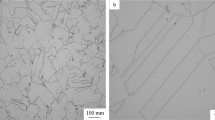Abstract
Alloy 22 (N06022) is a nickel-based alloy highly resistant to corrosion. In aggressive conditions of high chloride concentration, temperature, and applied potential, alloy 22 may suffer crevice corrosion, a form of localized corrosion. Several electrochemical methods can be used to detect localized corrosion in metallic alloys. One of the most popular for rapid screening is cyclic potentiodynamic polarization (CPP). This work compares the repassivation potentials obtained using CPP to repassivation potentials obtained using the Tsujikawa-Hisamatsu Electrochemical method and the potentiostatic method.
Similar content being viewed by others
References
Book of Standards Volume 03.02, Standards G 5, G 15, G 48, G 59, G 61, G 102 (West Conshohocken, PA: ASTM International, 2003).
“Hastelloy C-22 Alloy,” Brochure H-2019E (Kokomo, IN: Haynes International, 1997).
R.B. Rebak, Corrosion and Environmental Degradation, Volume II (Weinheim, Germany: Wiley-VCH, 2000), p. 69.
R.B. Rebak and P. Crook, Advanced Materials and Processes, 157 (2) (2000), pp. 37–42.
Yucca Mountain Science and Engineering Report, DOE/RW-0539 (Las Vegas, NV: U.S. Department of Energy, Office of Civilian Radioactive Waste Management, May 2001).
G.M. Gordon, Corrosion, 58 (2002), p. 811.
B.A. Kehler, G.O. Ilevbare, and J.R. Scully, Corrosion, 57 (2001), p. 1042.
K.J. Evans and R.B. Rebak, Corrosion Science—A Retrospective and Current Status in Honor of Robert P. Frankenthal, PV 2002-13 (Pennington, NJ: The Electrochemical Society, 2002), pp. 344–354.
K.J. Evans et al., Transportation, Storage and Disposal of Radioactive Materials-2003, PVP-Vol. 467 (New York: ASME, 2003), p. 55.
S.D. Day, K.J. Evans, and G.O. Ilevbare, Critical Factors in Localized Corrosion IV, PV 2002-24 (Pennington, NJ: The Electrochemical Society, 2003), p. 534.
D.S. Dunn, G.A. Cragnolino, and N. Sridhar, Scientific Basis for Nuclear Waste Management XXIV, Vol. 608 (Warrendale, PA: Materials Research Society, 2000), p. 89.
G.A. Cragnolino, D.S. Dunn, and Y.-M. Pan, Scientific Basis for Nuclear Waste Management XXV, Vol. 713 (Warrendale, PA: Materials Research Society, 2002), p. 53.
V. Jain et al., Corrosion/2003, Paper 03690 (Houston, TX: NACE International, 2003).
D.S. Dunn et al., Corrosion/2003, Paper 03697 (Houston, TX: NACE International, 2003).
N.S. Meck et al., Corrosion/2003, Paper 03682 (Houston, TX: NACE International, 2003).
J.H. Lee, T.S.E. Summers, and R.B. Rebak, Corrosion/2004, Paper 04692 (Houston, TX: NACE International, 2004).
D.S. Dunn et al., Corrosion/2004, Paper 04698 (Houston, TX: NACE International, 2004).
S. Tsujikawa and Y. Hisamatsu, Corr. Eng. Japan, 29 (1980), p. 37.
M. Akashi, G. Nakayama, and T. Fukuda, Corrosion/98, Paper 98158 (Houston, TX: NACE International, 1998).
K.J. Evans, L.L. Wong, and R.B. Rebak “Determination of the Crevice Repassivation Potential of Alloy 22 by a Potentiodynamic-Galvanostatic-Potentiostatic Method,” PVP-ASME Vol. 483 (New York: American Society of Mechanical Engineers, 2004), pp. 137–149.
G.O. Ilevbare, “The Effect of Sulfate Anions on the Crevice Corrosion in Alloy 22” (submitted for publication to Corrosion Journal).
C.S. Brossia et al., Effect of Environment on the Corrosion of Waste Package and Drip Shield Materials, CNWRA 2001-03 (San Antonio, TX: Center for Nuclear Waste Regulatory Analyses, September 2001).
Author information
Authors and Affiliations
Additional information
For more information, contact Raúl B. Rebak, Lawrence Livermore National Laboratory, 7000 East Ave., L-631, Livermore, CA 94550; (925) 422-1854; fax (925) 422-2105; e-mail rebak1@llnl.gov.
Rights and permissions
About this article
Cite this article
Evans, K.J., Yilmaz, A., Day, S.D. et al. Using electrochemical methods to determine alloy 22’s crevice corrosion repassivation potential. JOM 57, 56–61 (2005). https://doi.org/10.1007/s11837-005-0065-6
Issue Date:
DOI: https://doi.org/10.1007/s11837-005-0065-6




